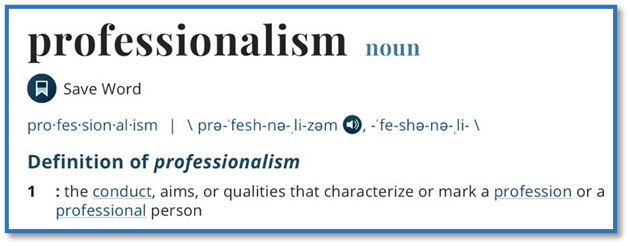This part of this module looks at your soft skills. These are the personal attributes you bring to the workplace that enable you to ‘fit in’. They include your personality, attitude, flexibility, motivation, and manners. Soft skills are so important that they are often the reason employers decide whether to take on, keep or promote an employee.

What we're covering:
"Being professional" is very important in the workplace but what does this actually mean? The Oxford dictionary defines a profession as being "a paid occupation, especially one that involves prolonged training and a formal qualification."
Professionalism involves much more than just being good at your job, however. Professional behaviour in the workplace is a combination of attitude, appearance and manners. It includes the way you speak, look, act and make decisions.

Professionalism is not the job you do; it's how you do the job.
Being competent is a minimum standard. The rest of what gives meaning to workplace professionalism is all about your behaviour. It’s not just what you know - it’s how you do your job, how you behave, and how you come across in your interactions with others. This video discusses some of the things you should (and shouldn’t) do when you start out in an electrical career. Take note of the key messages.
Activity
Research the characteristics of a professional person, then choose the top ten qualities or behaviours you think an electrical worker should demonstrate in the workplace. Download this worksheet and write your answers in the spaces provided. Then upload your completed worksheet into the class forum. Look at what your classmates have written and provide feedback for them.
Ethical Behaviour
Ethics is a system of moral standards that affect how people make decisions and lead their lives. Ethics includes actions, attitudes, beliefs, values, and behaviours combined.
Ethics covers the following:
- How to live a good life.
- Our rights and responsibilities.
- The language of right and wrong.
- Moral decisions - what is good and bad?
Work ethics means the way people conduct themselves in the workplace.
A good work ethic promotes a sense of teamwork, trust, pride, and inclusion within the business. The opposite fosters lower overall morale, high turnover rates, poor production, and bad feelings.
Activity
Read the following scenario, then decide what Zoheb should do and explain whether this is the ethical action to take.
During his break Zoheb was playing basketball in the carpark. During the pick-up game, which went way past his break-time, he slipped and twisted his ankle. His boss saw him limping back in the workshop after break, and thinking Zoheb had slipped on the job, told him to fill out an incident report. His boss offered to take care of Zoheb’s medical expenses and give him time off work, even though Zoheb was still capable of performing his work duties.
What should Zoheb do? Share your ideas in the class forum. Do you and your classmates agree?
Activity
Your workplace will most likely have a diverse workforce. Professional behaviour includes embracing and appreciating diversity and practicing inclusion so that employees feel equally important as their colleagues. Diversity is a word that describes the differences among people. It encompasses any dimension that can be used to differentiate groups and people from one another including age, gender, ethnicity, religion, socio-economic, disability, sexual orientation, education, and national origin.
Answer the following and post your thoughts on the group forum:
- What are some challenges of diversity in the workplace?
- How does diversity benefit the workplace?
- What can team members do or say to help create the feeling of inclusion within the team?
- Name a stereotype associated with the culture you identify with that is not consistent with who you are. Complete the following sentence:
I am (a/an) ____________________ but I am NOT(a/an) ____________________.

What we're covering:
- verbal and non-verbal communication
Becoming a successful electrician takes time and requires a broad range of skills. A knowledge of math and physics will help you gain your qualifications, but to be a good electrician you will also need to interact effectively with others. You must learn to communicate effectively and build strong positive relationships with everyone you interact with – co-workers, managers, subcontractors, suppliers and customers. Often you will be dealing with people who do not have a working knowledge of electrical systems and do not understand the technical jargon, so the way you impart information will be very important. Poor communication wastes time, which in turn wastes money.
Communication involves transferring information from one person to another. We spend about 75% of our time communicating knowledge, thoughts, and ideas to others.
Workplace communication includes:
- Team meetings.
- 1:1 feedback sessions.
- Receiving information and instruction.
- Asking questions and confirming procedures.
- Communicating about the progress of the task.
- Collaborating on shared tasks.
- Nonverbal communication.
Talking is often seen as the most common method of communication but most communication is silent or non-verbal. Learning to read these non-verbal signals is all part of developing your communication skills. Communication can be harder when we can’t see these signs like when we use the phone, texts or email.
Verbal Communication
Words can mean many different things, depending on the way they are said. The tone, pitch and volume of your voice could change how your messages are received.
Try to avoid using jargon or abbreviations and be mindful that not everyone understands the complicated language and terminology of electricity. Make sure you always speak in a respectful way, adjusting your speech to suit the individual. The volume used and the speed the words are delivered will also affect how the message is interpreted.
Nonverbal Communication
93% of your message is conveyed by nonverbal means. So, before you even start speaking you have sent a strong message to the other person!
Non-verbal communication includes:
- Sign language – This is a recognised language throughout the world and one of the three official languages of New Zealand.
- Facial expressions - our faces show how we are feeling - a frown or a smile sends a very clear message. The appearance of a person’s face offers clues about ethnic origins, age, gender etc., while the expression on a person's face is a good indicator of their emotions - happiness, surprise, sadness, fear, anger, disgust, interest etc.
- Eye contact - is one of the most important nonverbal cues in western society. You are expected to meet other peoples' gazes when you communicate and failure to do so may be interpreted as being dishonest, bored or angry. In some societies however making eye contact is embarrassing and intrusive. When dealing with people from another culture be aware of their background and allow for the differences in their cultural behaviour.
- Gestures – These are hand or arm movements such as pointing, waving, and making a fist. Each of these will communicate information about an individual or a worker, often without them realising it.
- Posture - how you position your body is will provide others with clues about our feelings, attitude and emotions. Folding your arms is a closed posture suggesting you feel defensive or negative towards the other person. Leaning towards the other person shows interest in what they are saying or doing.

- Written communication – This method is used to send messages, keep records, or provide evidence. Without any non-verbal clues there is much more potential for messages to be misunderstood.
- Visual communication such as graphs and diagrams can be useful in written communication. It is a very powerful way of getting a message across and can be more powerful than verbal and non-verbal communication. Visual communication is much easier and more varied now due to the developments in technology.
Activity
Identify the emotions expressed by these non-verbal communication signs and describe actions you could take when your co-worker communicates in this way. Download the worksheet and complete your answers in the spaces provided. Then share your worksheet in the class forum and compare your thoughts with those of your classmates.
Toolbox Meetings
Toolbox meetings are informal chats, usually done on-site, about the jobs to be done that week. Everyone is given the opportunity to discuss safety measures and procedures, the work programme and how the job is tracking. Your team can raise any concerns they have, as well as discuss incidents that have happened since the last talk.
Toolbox talks should be run on a regular basis for 10-15 minutes, creating an ongoing channel for open communication.
A ‘successful’ toolbox meeting:
- Informs workers of any changes to company procedures.
- Identifies new hazards and reviews existing hazards.
- Develops/reviews hazard control measures.
- Discusses/reviews accident and incident data.
- Encourages employee participation.
- Creates an ongoing channel for open communication.
- Discusses the work programme.
- Develops/reviews work processes.
- Provides short training sessions.
Visit this site and identify the five steps involved in running a Toolbox Meeting.
Active Listening
Listening is not the same as hearing. Hearing refers to the sounds that enter your ears. It is a physical process that happens automatically (unless you have hearing problems).
Listening, requires focus and concentrated effort. It is just as important for communication in the workplace as talking is.
There are two common types of listening: listening to reply and listening to understand.
- When you listen to reply, you are focusing on what you’re going to say next, rather than what the other person is saying. With this type of listening, you risk missing key information or even repeating what the other person just said.
- When you listen to understand you listen to what the other person has to say without thinking about how you’re going to reply. If you do think of something you want to say or a question to ask - save it for later and go back to listening to understand.
You have a lot to learn on the job so listen carefully to avoid making mistakes. Listening to other people’s ideas instead of just trying to put your own ideas out there will also make you a popular team member.
Activity
Rate how well you listen by visiting this site and working through the Employment NZ Self-Assessment tool.

What we're covering:
- punctuality
- schedules
Punctuality
Showing up for work on time and being conscientious about your attendance, signals you are someone who is committed to your job and responsibilities. Many employers value dependability and reliability over technical abilities and qualifications.
Being punctual allows you to:
- Demonstrate your professionalism and leadership potential.
- Perform your assigned job tasks within the allotted time.
- Improve work relationships by sharing the load and helping the team effort.
- Create a positive image of you and your employer.
- Practice time-management skills.
- Reduce stress.
Work Schedule
A work schedule is essential for any tradesperson in order to:
- Provide Structure - Having a set number of hours to complete designated tasks encourages people to complete their work effectively and within the allotted time. Workers stay on-task when meeting deadlines becomes a priority.
- Monitor productivity – reviewing what has been accomplished during a shift helps confirm targets are being met and identify whether inefficient workflow and low work quality are an issue.
- Identify labour requirements – certain projects may require overtime, down-time, shifts work etc.
- Designate break times – Breaks are necessary (and a legal requirement) in order to rest and refuel. Errors through fatigue can result in costly repairs and serious injuries.
A work schedule enables electricians carrying out repairs at private residences to keep appointments and arrive on time. Since they will often visit more than one worksite in a day, they must be good at estimating how long a job will take to avoid arriving late for the next job.
Electricians working at a construction site, the schedule is useful to budget sufficient time to finish electrical projects without delaying the construction work as a whole. Construction projects work on a tight schedule with every delay in the project costing the client time and money. Additionally, electricians who work with a team must remain conscious of how their timeliness affects others. If one member of the team lags behind, parts of the project may not be able to move forward.
The following Gantt Chart shows the progression of a building project. Electrical work is scheduled for weeks 12-14 and 16-17. If this does not occur at the scheduled time, the entire project is pushed back at considerable cost and inconvenience.
| Time scale (weeks) | ||||||||||||||||||||||
|---|---|---|---|---|---|---|---|---|---|---|---|---|---|---|---|---|---|---|---|---|---|---|
| ID | Name | 1 | 2 | 3 | 4 | 5 | 6 | 7 | 8 | 9 | 10 | 11 | 12 | 13 | 14 | 15 | 16 | 17 | 18 | 19 | 20 | 21 |
| WBS1 | Ground | |||||||||||||||||||||
| 1 | Excavation | |||||||||||||||||||||
| 2 | Backfill compaction | |||||||||||||||||||||
| WBS2 | Structural | |||||||||||||||||||||
| 3 | Reinforced concrete | |||||||||||||||||||||
| 4 | Steel works | |||||||||||||||||||||
| WBS3 | Finishing | |||||||||||||||||||||
| 5 | Brick laying | |||||||||||||||||||||
| 6 | Wall plastering | |||||||||||||||||||||
| 7 | Painting | |||||||||||||||||||||
| 8 | Floor covering | |||||||||||||||||||||
| WBS4 | Electrical | |||||||||||||||||||||
| 9 | Conduit | |||||||||||||||||||||
| 10 | Cable pulling | |||||||||||||||||||||
| WBS5 | Mechanical | |||||||||||||||||||||
| 11 | Plumbing | |||||||||||||||||||||
| 12 | Fittings | |||||||||||||||||||||
Gantt Charts are efficient tools to create a work schedule. Tasks, milestones, and deliverables are demonstrated as bars. All the activities are listed under certain Work Breakdown Structure (WBS) levels on the left. The timescale shows the total project duration divided into weeks. The duration of each activity is represented by cells.

What we're covering:
- workplace expectations
- workplace policies
More and more employers are choosing to:
Hire for attitude, train for skills.
In other words, their hiring decision is based on “who you are” first and “what you know” second. The preference is to employ people with a (good) attitude — traits like enthusiasm, humility, work ethic, integrity, initiative, passion — because these kinds of personality traits are virtually impossible to learn. Usually, you either have them or you don't. Experience, skills and qualifications, on the other hand, can be taught.
It is helpful to understand what the rules are that cover your workplace when you are setting out. You must clearly understand what is expected of you at work and how you will contribute to the success of the organisation. Clear workplace policies and procedures mean everyone knows how things are meant to be done.
Visit the Employment New Zealand website to find out more about starting out in the workforce.
Sometimes things go wrong in the workplace, and it is important to understand your rights and responsibilities. When you and your employer enter into an employment relationship there are a number of must do’s including:
- Doing things in a way that shows good faith.
- Doing things for good reason.
- Using a fair process.
Good faith means acting in a way that is honest and does not mislead each other. It entails clear and accurate communication between employees and their managers, with any concerns raised in a genuine and honest way.
Good reason is about making sure that there is a good (genuine) reason for taking an action against an employee, such as: misconduct; disestablishment of the job; failure to meet the expectations of the job; a fundamental breakdown in the employment relationship, etc.
Fair Process must be followed if any action is taken against an employee, according to the requirements of the Employment Relations Act 2000 and natural justice. Concerns must be fully investigated and properly raised with the employee. The employee must be given reasonable opportunity to tell their side of the story, seek independent advice and representation at any disciplinary meetings. Employees must be treated without bias and all options must be considered before a final decision is made.
Activity
Read through the following examples and decide whether fair or unfair treatment is apparent.
- Ben invites the boss to his house often for lunch. The boss gives Ben a pay-increase even when Ben does not do his job properly.
- Lisa and Arlo have a dispute and the case is under arbitration. When Lisa hears that the arbitrator appointed is her uncle Jeremiah, she calls him and asks him not to declare the relationship and to help her win the dispute.
- When Jim is praised for work that Rongo has done, he tells his boss honestly that Rongo deserved the praise.
- Chen realises that his son, Lee, who is also his employee is slacking off because he thinks he can get away with it. Chen calls Lee into his office and reprimands him and gives him a verbal warning. When Lee doesn’t take him seriously, he is issued with a warning letter.
- Sanjay collects bits of junk from houses he is renovating and sells them for a profit without informing the owner or the building contractor.
Click the + button to the right to find out how well you did.
If you said that examples 3 and 4 showed the principles of fair, right and just dealings, you would be correct.
The principles can be summarised as follows:
- Being fair, right and just involves having common rules. Underlying the feeling of fairness has to be some trust and transparency.
- There must be trust and transparency.
- People are treated on an equal footing.
- Give others an equal chance to be heard, whether it’s allowing them to share great ideas or to air grievances.
- Give others credit where credit is due.
- Care for the well-being of others.
This is considered so important in business, there is a law called the Fair-Trading Act 1986 which sets out how customers are to be treated by businesses.
EWRB Disciplinary Process
Because there sometimes needs to be some way of dealing with those that do not uphold standards, the Electrical Workers Registration Board (EWRB) exists. If you are a registered electrical worker and a complaint is made about your work or conduct, you will receive a letter informing you of this from the registrar of the Electrical Workers Registration Board (EWRB). This letter will ask you to respond to the complaint.
An investigation will be held. If the complaint is not valid or serious, the outcome may be that no further action needs to be taken.
Otherwise, the board will hold a disciplinary hearing. At the hearing, the Board will listen to evidence from relevant parties and make a decision.
If you are found not guilty, the matter ends there. If you are found guilty, the board may impose penalties, including suspension or removal of registration, orders to cease electrical work or orders to undergo remedial training. You may also be censured or fined.
Activity
Congratulations on reaching the end of Module 1! In this module and in the classroom we have covered:
- Safety procedures when working with electricity
- First aid
- Power and hand tools
- Basic electrical tasks
- Legislation
- The national power grid
- Professionalism
Good luck with your assessments, you’ve got this!!!
